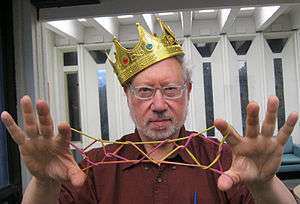Louis Kauffman

Louis Hirsch Kauffman (born February 3, 1945) is an American mathematician, topologist, and professor of Mathematics in the Department of Mathematics, Statistics, and Computer science at the University of Illinois at Chicago. He is known for the introduction and development of the bracket polynomial and the Kauffman polynomial.
Biography
Kauffman was valedictorian of his graduating class at Norwood Norfolk Central High School in 1962. He received his B.S. at MIT in 1966 and his Ph.D. in mathematics from Princeton University in 1972 (with the famous mathematician William Browder as thesis advisor).
Kauffman has worked at many places as a visiting professor and researcher, including the University of Zaragoza in Spain, the University of Iowa in Iowa City, the Institute Hautes Etudes Scientifiques in Bures Sur Yevette, France, the Institute Henri Poincaré in Paris, France, the Università di Bologna, Italy, the Universidade Federal de Pernambuco in Recife, Brazil, and the Newton Institute in Cambridge England.[1]
He is the founding editor and one of the managing editors of the Journal of Knot Theory and Its Ramifications, and editor of the World Scientific Book Series On Knots and Everything. He writes a column entitled Virtual Logic for the journal Cybernetics and Human Knowing
From 2005 to 2008 he was president of the American Society for Cybernetics. He plays clarinet in the ChickenFat Klezmer Orchestra in Chicago.
Work
Kauffman's research interests are in the fields of cybernetics, topology and foundations of mathematics and physics. His work is primarily in the topics of knot theory and connections with statistical mechanics, quantum theory, algebra, combinatorics and foundations. [2] In topology he introduced and developed the bracket polynomial and Kauffman polynomial.
Bracket polynomial
In the mathematical field of knot theory, the bracket polynomial, also known as the Kauffman bracket, is a polynomial invariant of framed links. Although it is not an invariant of knots or links (as it is not invariant under type I Reidemeister moves), a suitably "normalized" version yields the famous knot invariant called the Jones polynomial. The bracket polynomial plays an important role in unifying the Jones polynomial with other quantum invariants. In particular, Kauffman's interpretation of the Jones polynomial allows generalization to state sum invariants of 3-manifolds. Recently the bracket polynomial formed the basis for Mikhail Khovanov's construction of a homology for knots and links, creating a stronger invariant than the Jones polynomial and such that the graded Euler characteristic of the Khovanov homology is equal to the original Jones polynomial. The generators for the chain complex of the Khovanov homology are states of the bracket polynomial decorated with elements of a Frobenius algebra.
Kauffman polynomial
The Kauffman polynomial is a 2-variable knot polynomial due to Louis Kauffman. It is defined as
where is the writhe and is a regular isotopy invariant which generalizes the bracket polynomial.
Discrete ordered calculus
In 1994, Kauffman and Tom Etter wrote a draft proposal for a non-commutative discrete ordered calculus (DOC), which they presented in revised form in 1996.[3] In the mean time, the theory was presented in a modified form by Kauffman and H. Pierre Noyes together with a presentation of a derivation of free space Maxwell equations on this basis.[4]
Awards and honors
He won a Lester R. Ford Award (with Thomas Banchoff) in 1978.[5] Kauffman is the 1993 recipient of the Warren McCulloch award of the American Society for Cybernetics and the 1996 award of the Alternative Natural Philosophy Association for his work in discrete physics. He is the 2014 recipient of the Norbert Wiener award of the American Society for Cybernetics.[6]
In 2012 he became a fellow of the American Mathematical Society.[7]
Publications
Louis H. Kauffman is author of several monographs on knot theory and mathematical physics. His publication list numbers over 170.[1] Books:
- 1987, On Knots, Princeton University Press 498 pp.
- 1993, Quantum Topology (Series on Knots & Everything), with Randy A. Baadhio, World Scientific Pub Co Inc, 394 pp.
- 1994, Temperley-Lieb Recoupling Theory and Invariants of 3-Manifolds, with Sostenes Lins, Princeton University Press, 312 pp.
- 1995, Knots and Applications (Series on Knots and Everything, Vol 6)
- 1995, The Interface of Knots and Physics: American Mathematical Society Short Course January 2-3, 1995 San Francisco, California (Proceedings of Symposia in Applied Mathematics), with the American Mathematical Society.
- 1998, Knots at Hellas 98: Proceedings of the International Conference on Knot Theory and Its Ramifications, with Cameron McA. Gordon, Vaughan F. R. Jones and Sofia Lambropoulou,
- 1999, Ideal Knots, with Andrzej Stasiak and Vsevolod Katritch, World Scientific Publishing Company, 414 pp.
- 2001, Knots and Physics (Series on Knots and Everything, Vol. 1), World Scientific Publishing Company, 788 pp.
- 2002, Hypercomplex Iterations: Distance Estimation and Higher Dimensional Fractals (Series on Knots and Everything , Vol 17), with Yumei Dang and Daniel Sandin.
- 2006, Formal Knot Theory, Dover Publications, 272 pp.
- 2007, Intelligence of Low Dimensional Topology 2006, with J. Scott Carter and Seiichi Kamada.
- 2012, Knots and Physics (Fourth Edition), World Scientific Publishing Company, ISBN 978-981-4383-00-4
Articles and papers, a selection:
- 2001, The Mathematics of Charles Sanders Peirce, in: Cybernetics & Human Knowing, Vol.8, no.1–2, 2001, pp. 79–110
References
- 1 2 http://www.math.uic.edu/~kauffman/569.html
- ↑ Presentation
- ↑ T. Etter, L.H. Kauffman, ANPA West Journal, vol. 6, no. 1, pp. 3–5
- ↑ Louis H. Kauffman, H. Pierre Noyes, Discrete physics and the derivation of electromagnetism from the formalism of quantum mechanics, Proceedings of the Royal Society London A (1996), vol. 452, pp. 81–95
- ↑ Kauffman, Louis; Banchoff, Thomas (1977). "Immersions and Mod-2 quadratic forms". Amer. Math. Monthly. 84: 168–185. doi:10.2307/2319486.
- ↑ About SSC: Awards, retrieved 2014-11-02.
- ↑ List of Fellows of the American Mathematical Society, retrieved 2013-01-27.
External links
| Wikiquote has quotations related to: Louis Kauffman |
- Louis Kauffman homepage at uic.edu
- Hypercomplex Fractals
- Arxiv Papers
- Louis Kauffman at the Mathematics Genealogy Project
- ChickenFat Klezmer Orchestra